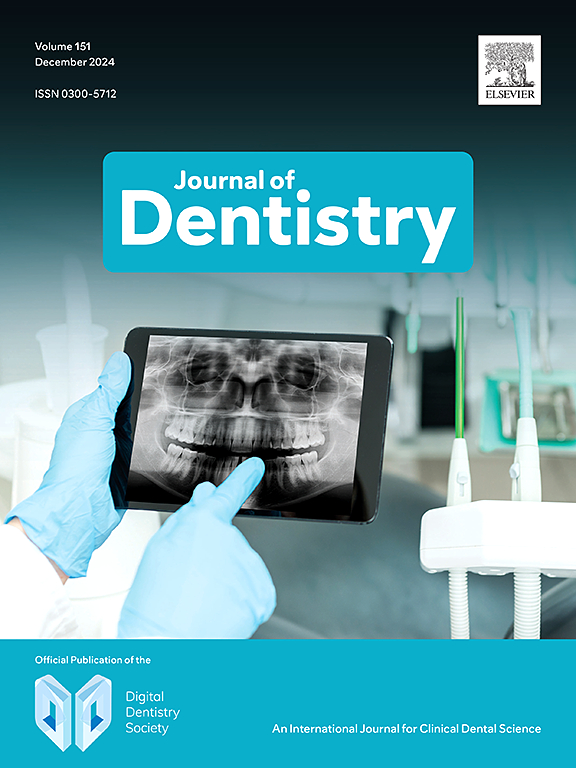One-piece zirconia oral implants supporting three-unit fixed dental prostheses: Ten-year results from a prospective case series
IF 5.5
2区 医学
Q1 DENTISTRY, ORAL SURGERY & MEDICINE
引用次数: 0
Abstract
Objectives
This prospective case series aimed to evaluate the long-term clinical and radiographic outcomes of one-piece zirconia implants used to support three-unit fixed dental prostheses after a decade of functional loading. The primary endpoint was implant survival.
Materials and methods
A total of 54 implants were placed in 27 patients using a one-stage surgical approach with immediate provisionalization. Peri-implant bone loss was assessed using standardized radiographs; soft-tissue parameters were also evaluated. Statistical analysis was conducted using linear mixed regression models and Wilcoxon Signed Rank tests to compare differences over time and between variable groups (p < 0.05).
Results
One patient was lost to follow-up after one year, and another declined participation in the 10-year evaluation. Over the 10-year period, 21 implants failed, leading to a cumulative survival rate of 59.26 %. The mean marginal bone loss of the remaining implants was measured at 1.61 mm. Probing depth, clinical attachment loss, bleeding on probing and plaque index showed an increase from the initial prosthesis placement to the 10-year follow-up.
Conclusions
The studied one-piece zirconia implants demonstrated lower survival rates compared to previously reported survival rates of zirconia and titanium implants. Implant failures were mainly due to peri‑implantitis, necessitating their removal. This specific implant is not commercially available.
Clinical significance
Despite favorable initial outcomes, the one-piece zirconia implants studied showed a low 10-year survival rate, primarily due to peri‑implantitis. These findings highlight the importance of long-term monitoring and material selection when using zirconia implants to support multi-unit restorations. Clinicians should exercise caution with similar implant designs.
一体式氧化锆口腔种植体支持三单元固定义齿:前瞻性病例系列的十年结果。
目的:本前瞻性病例系列旨在评估在功能负荷十年后,用于支持三单元固定义齿的一体式氧化锆种植体的长期临床和影像学结果。主要终点是种植体存活。材料和方法:27例患者共植入54颗种植体,采用一期手术方式,即刻修复。采用标准化x线片评估种植体周围骨质流失;软组织参数也进行了评估。采用线性混合回归模型和Wilcoxon sign Rank检验进行统计学分析,比较不同时间和不同变量组间的差异(p < 0.05)。结果:1例患者1年后失去随访,1例患者拒绝参加10年评估。10年间,21例植入失败,累计生存率为59.26%。剩余种植体的平均边缘骨损失为1.61 mm。探针深度、临床附着丧失、探针出血和斑块指数从最初放置假体到10年随访均有所增加。结论:与之前报道的氧化锆和钛种植体的存活率相比,所研究的一体式氧化锆种植体的存活率更低。种植体失败主要是由于种植体周围炎,需要将其移除。这种特殊的植入物还没有市售。临床意义:尽管初步结果良好,但研究的一体式氧化锆种植体的10年生存率较低,主要是由于种植体周围炎。这些发现强调了使用氧化锆植入物支持多单元修复时长期监测和材料选择的重要性。临床医生应谨慎对待类似的植入物设计。
本文章由计算机程序翻译,如有差异,请以英文原文为准。
求助全文
约1分钟内获得全文
求助全文
来源期刊

Journal of dentistry
医学-牙科与口腔外科
CiteScore
7.30
自引率
11.40%
发文量
349
审稿时长
35 days
期刊介绍:
The Journal of Dentistry has an open access mirror journal The Journal of Dentistry: X, sharing the same aims and scope, editorial team, submission system and rigorous peer review.
The Journal of Dentistry is the leading international dental journal within the field of Restorative Dentistry. Placing an emphasis on publishing novel and high-quality research papers, the Journal aims to influence the practice of dentistry at clinician, research, industry and policy-maker level on an international basis.
Topics covered include the management of dental disease, periodontology, endodontology, operative dentistry, fixed and removable prosthodontics, dental biomaterials science, long-term clinical trials including epidemiology and oral health, technology transfer of new scientific instrumentation or procedures, as well as clinically relevant oral biology and translational research.
The Journal of Dentistry will publish original scientific research papers including short communications. It is also interested in publishing review articles and leaders in themed areas which will be linked to new scientific research. Conference proceedings are also welcome and expressions of interest should be communicated to the Editor.
 求助内容:
求助内容: 应助结果提醒方式:
应助结果提醒方式:


